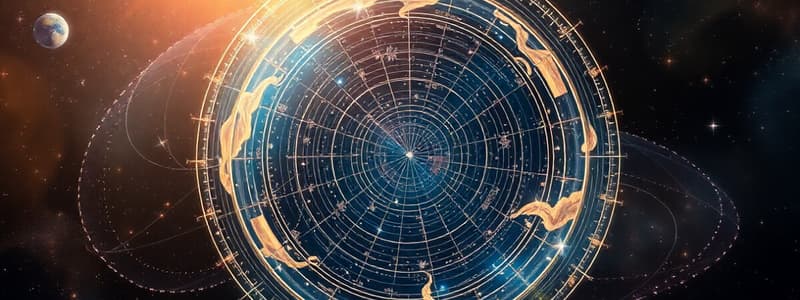Podcast
Questions and Answers
What does celestial mechanics primarily focus on?
What does celestial mechanics primarily focus on?
- The energy levels of celestial bodies
- The gravitational forces between planets
- The motions of objects in outer space (correct)
- The properties of matter on Earth
What was one observation supporting the geocentric model?
What was one observation supporting the geocentric model?
- Celestial objects are made of matter
- Earth feels solid and stationary (correct)
- Stars move in a circular path around the Sun
- The Moon's phases change every year
In the geocentric model, which celestial object is said to revolve around Earth once per day?
In the geocentric model, which celestial object is said to revolve around Earth once per day?
- The planets only
- The Sun, Moon, and planets (correct)
- The Sun only
- The stars only
What concept did Aristotle introduce regarding celestial objects?
What concept did Aristotle introduce regarding celestial objects?
What element did Aristotle believe celestial spheres were made of?
What element did Aristotle believe celestial spheres were made of?
What is the nature of the motion that celestial objects exhibit according to the geocentric model?
What is the nature of the motion that celestial objects exhibit according to the geocentric model?
According to Aristotelian physics, what was fixed and not subject to motion?
According to Aristotelian physics, what was fixed and not subject to motion?
What kind of motion does the Sun exhibit in relation to the stars?
What kind of motion does the Sun exhibit in relation to the stars?
Flashcards are hidden until you start studying
Study Notes
Mechanics and Celestial Mechanics
- Mechanics studies the relationships between force, matter, and motion of physical objects.
- Celestial mechanics specifically examines the motion of objects in outer space.
Historical Models of the Universe
- The geocentric model, popular among European philosophers, posits Earth at the center of the universe.
- Two primary observations supported the geocentric view:
- Earth appears stable and unmoving from a surface perspective.
- The Sun, Moon, and planets seem to revolve around Earth daily.
The Movement of Celestial Objects
- Stars appear fixed on a celestial sphere that rotates daily around Earth's geographic poles.
- Under the geocentric model, celestial objects orbit around Earth.
- Celestial bodies exhibit distinct motions:
- Stars show a daily westward movement.
- The Sun has an annual eastward motion.
- The Moon exhibits a monthly eastward motion.
Aristotelian Physics
- In the 4th century BC, Aristotle contributed significantly to natural philosophy linked with the geocentric model.
- He proposed that celestial objects reside in concentric spheres rotating at fixed rates.
- The celestial spheres consist of aether, which is characterized by uniform circular motion.
Order of Celestial Spheres
- The arrangement of celestial spheres radiates outward from Earth, following decreasing orbital periods:
- The Moon completes its orbit in one month.
- The Sun completes its orbit in one year.
- Each sphere of celestial objects maintains its own unique motion relative to the outer sphere of stars.
Key Takeaways
- Celestial mechanics integrates scientific disciplines such as astronomy and mathematics.
- Historical models of the universe, especially the geocentric view, were shaped by observational evidence and philosophical reasoning.
Studying That Suits You
Use AI to generate personalized quizzes and flashcards to suit your learning preferences.




